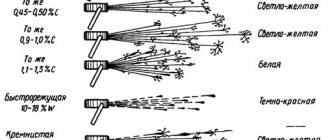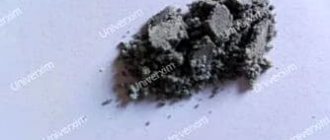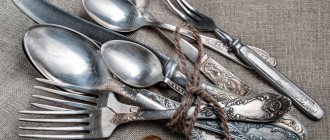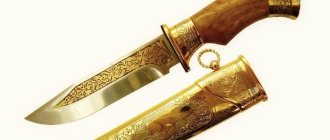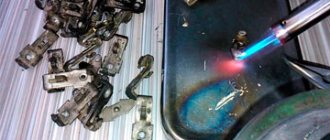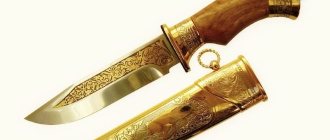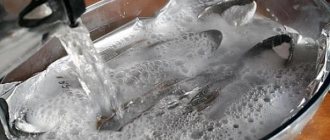Not every family can boast of having silver cutlery, and there are very few owners of complete sets. It would seem that silver is not a very expensive metal - a simple ring can be purchased for only a thousand rubles.
Why is silverware so expensive? And you count how much precious metal it takes to make one silver spoon. Plus work, a brand and other extras - a substantial amount accumulates.
Therefore, often the desire to determine the authenticity of silver spoons is not a whim, but a matter of prestige, the feasibility of financial investments and the characteristics of care. Especially if we are talking about family or any other rare silver.
Identifying real metal
To understand how to distinguish silver from other metals, you need to clearly understand the main characteristics of the imitations that are so often passed off as silver. It becomes clear that modern jewelry factories and industrial factories conduct careful control and do not allow silver of dubious quality to enter the market. They all work in accordance with certain standards and GOSTs, so you don’t have to worry about quality when purchasing silver products from reliable places and trusted jewelry stores.
Tactile method
There are several tactile ways to distinguish silver from cupronickel and other fakes. One of them was described above, namely, to heat the product. But, in addition to temperature, after heating an object by rubbing it with your hand, you should pay attention to the skin. If there are no stains left on it, most likely it is high-quality silver, but dark marks remaining on the skin indicate that the product contains too much zinc, which is harmful to the body, and you should not wear such jewelry or use such utensils.
The authenticity of silver can also be determined by the weight of the item: silver is much heavier than other metals. This task is best handled by a professional, but an ordinary person can determine its authenticity by simply comparing the weight of the item with a similar silver one.
View gallery
Magnet
A less reliable, but still valid method for distinguishing silver from other metals is a magnet. Very often I insert silver parts into products made from ordinary, base metals. For example, these could be links in a chain with a sample. In this case, a magnet can help; silver is never attracted to it. But this method is not reliable, since not only does the magnet not attract silver, but cupronickel and non-ferrous metals also do not react to the magnet.
Another common way to counterfeit silver jewelry or tableware is to coat copper or other metal with a thin layer of silver. In this case, a regular needle can help distinguish a fake. It is enough to scratch the product with it, and if dark metal appears inside, then it is definitely a fake. However, this method is not suitable for those who are afraid of ruining the appearance of the item.
Cupronickel alloys
Cupronickel alloys can have different percentage compositions of substances. The most popular cupronickel alloy contains from 5 to 30 percent nickel, with the remaining percentages being iron (0.8 percent) and manganese (0.1 percent).
There are other alloys that are very similar in their chemical composition to cupronickel, but have different names:
- Cupronickel contains only copper and nickel in equal proportions;
- Monel, contains up to 67 percent nickel;
- nickel silver, contains additional zinc;
- Constantan contains 55 percent copper and 45 percent nickel.
Cupronickel products are easily soldered and polished. In the manufacture of cupronickel products, special solders based on tin-lead or silver alloys can be used. Cupronickel is well processed, alloyed with other metals, cut, forged, embossed, stamped, polished and soldered. Such properties of cupronickel make it possible to effectively use it to replace natural silver.
The attractive appearance has allowed the copper alloy to occupy a stable niche in jewelry, no longer for counterfeiting silver items, but as an independent alloy.
How to distinguish a silver spoon from a cupronickel spoon
Cupronickel is an alloy of copper and nickel, that is, the same metals that are usually added to silver-based jewelry alloys. It has been known almost since the beginning of our era, but it began to be actively used for the production of cutlery relatively recently, about 150 years ago.
Mark on a cupronickel spoon
In Soviet times, cupronickel cutlery was very popular and was the pride of middle-income families. They were traditionally marked with the mark “MELCH”. But there are other analogues of silver: Monel (“MN”, cupronickel with a high nickel content), nickel silver (“MNTs”, with the addition of zinc), silver-plated brass, and so on.
It is quite difficult to distinguish silver from nickel silver on cutlery at home, especially if there is no factory mark. You can scratch the product: a dark mark will remain on cupronickel, and a light mark will remain on silver, the metal’s own shade. But it is better to use the jewelry tests already mentioned above.
And finally: never buy silverware second-hand without a preliminary professional assessment, and then you will not have to suffer from doubts!
Source
How to identify genuine silver: home tricks
15.12.2019 | 08:17 |
Nowadays, gold and silver are even sold in the market and on the Internet. Prices there, of course, are lower, so you really want to save money or buy two for the price of one store item. But in this case, no one is safe from counterfeiting. With gold, everything is clear: just apply a little tooth powder to a slightly moistened cotton pad and rub the product. If dark stripes remain, then the metal is genuine. What about silver? Let me explain.
Sample and touchstone
Modern rules that form the basis for the circulation of precious metals make it possible to distinguish copper and other additives from silver, as well as determine their content in a product. For this purpose, a measure has been established, the so-called test. And to monitor compliance with the rules, special devices have been invented.
You need to know about the sample system and the rules for their use:
- The sample shows how much Ag is contained in the alloy. It represents a three-digit number. Conventionally, each unit here means 1 gram in 1 kilogram. But kilogram jewelry is a thing of the past. Therefore, the measuring unit on modern products simply shows every tenth of a percent of argentum.
- When making jewelry, 925 alloys are most often used. This means that they contain 92.5% Ag and 7.5% copper.
- Less common hallmarks: 750, 800, 875, 916, 960. 999 alloy (almost pure precious metal) is used only for specialty bars, high-value collectible coins and in some high-precision fields of science.
- If a product claims to be called silver, the purity must be indicated on it. It is applied by branding. Information about it is also indicated on the attached product label. The label fastening must be sealed. If the seller does not comply with these mandatory, legally established conditions, there is a high chance of encountering a counterfeit.
- In addition to the sample, the label must contain other information about the decoration. This is its name, weight, total price and price per 1 gram, name of the manufacturer, description of the stones (if any). If the product is plated (for example, rhodium), this must also be indicated.
- Information about the name, weight, sample, and price of the product must also be included in the purchase receipt.
- You can test the product for samples and additives using a touchstone. To do this, you will need to make a scratch on the jewelry and drip the reagent. Brown color, for example, will indicate the presence of brass. The yellow color will help distinguish silver from tin (lead will also signal its presence with yellow).
You can purchase the stone at a jewelry store. It should come along with a plate from which, depending on the reaction of the alloy, its composition can be accurately calculated. Now good stones are offered at prices ranging from 700-800 rubles.
Russia, of course, is not Latin America, whose countries are world leaders in argentum production. But there is also enough silver in the state. Citizens do not encounter counterfeits very often. To avoid them, as a rule, it is enough to purchase jewelry in specialized stores , and not at market stalls or station stalls.
How to tell if a spoon is silver
Silver is a precious metal, which means that all products made from it are subject to hallmarking. In addition to the required image, the mark contains numbers reflecting the percentage of metal content.
Nowadays three-digit hallmark designations are accepted, but in tsarist Russia they were two-digit. And the brand looked completely different.
Pure silver is used exclusively for technical purposes. In the production of jewelry and decorative items, as well as cutlery, silver is used with additives that give it strength.
The most popular additives for silver are copper and nickel. This is why silverware often has a yellowish tint - these are traces of copper. The higher the sample, the less noticeable this yellowness is.
Set of silver teaspoons
So factory-made silverware is always hallmarked, but there is still a risk of running into a fake - craftsmen have learned to falsify even standard hallmarks. However, silver is supplied with fake hallmarks much less often than gold (simply unprofitable), and the quality of the imprint itself leaves much to be desired.
If there is no mark on the product or you doubt its origin, you can check the silverware for authenticity using homemade methods:
- Chalk. Run a regular chalk across the surface of the silver - a dark mark will remain on the white mineral. True, some other metals (for example, tin) demonstrate a similar reaction, so this test is not very informative.
- Sulfur ointment. Sulfur is the worst enemy of silver: upon contact with it, the noble metal is covered with a dark layer of sulfide. Apply sulfur ointment to a small, inconspicuous area, wait 10-15 minutes and watch the metal react.
- Lapis pencil. The ancient styptic can be used to test gold and silver. It contains silver nitrate, and it does not leave the slightest trace on precious metals.
- Iodine. But silver reacts to iodine - dark spots remain. If the spots are a different color or there is no reaction at all, then this means that this is a fake. The only disadvantage of this method is that it is difficult to remove a dark stain from silver later.
- Ice. Silver has high thermal conductivity: a piece of ice placed in a spoon will begin to melt rapidly. To compare the result, it is advisable to simultaneously perform a similar experiment with a guaranteed non-silver spoon.
If you want to get a perfectly accurate result, buy a special test at a jewelry store. It is inexpensive, but allows you to instantly resolve doubts about the “pedigree” of the product.
The methods described above are relatively good, but there are a lot of nuances that reduce the accuracy of testing.
To begin with, in most cases we do not test the entire product, but its surface, so a silver-plated spoon will test positive for silver. The only way to get to the truth is to scratch deep into the surface and test there. By the way, silver-plated products are not branded!
The second nuance is rhodium-plated (that is, rhodium-plated) silver. Rhodium-plated silver does not darken over time, has an elegant shine and demonstrates much greater strength. There will be a factory mark on it, but the rhodium-plated surface, naturally, will not give a positive reaction to silver.
Silver tea spoon
How much does a silver table spoon weigh?
Silver is a dense and, accordingly, heavy metal. A silver tablespoon will be much heavier than a steel one, and even more so an aluminum one. True, cupronickel cannot be called light either.
The weight of a modern silver tablespoon ranges from 55-95 grams, but antique cutlery can be even heavier.
Weight of a silver teaspoon
Even a miniature silver spoon feels good in the hand. The standard weight of such a device is 25-40 grams.
For babies, “for the first tooth” they usually take even lighter spoons weighing 12-20 grams. If you want to follow the tradition, but do not intend to feed your child from a silver spoon, you can purchase its stylization in the form of a pendant.
Cupronickel as an imitation of silver
Cupronickel has a lot in common with silver in appearance. Silver is a precious, expensive metal, from which not only dishes were made, but also jewelry, coins, and figurines. Silver is often replaced with similar and inexpensive cupronickel.
That is why it is important to distinguish cupronickel from silver in a store, market, souvenir shop or at home.
Cupronickel is an alloy of copper, nickel and zinc. Outwardly, cupronickel is very similar to silver, which is what many take advantage of by selling counterfeits of cupronickel under the guise of this precious metal. In everyday life, there may be difficulties in solving the problem of distinguishing nickel silver products from silver products.
Historically, cupronickel has been a good imitation of silver. The color of such an alloy depends on the percentage of copper in its composition and can vary from yellowish to red-yellow shades. Manganese and iron are added to make the material resistant to corrosion. Cupronickel products have a pleasant silvery sheen.
How to distinguish silver from cupronickel at home?
Since ancient times, silver cutlery has been considered a sign of wealth and unique taste.
But not everyone could afford such a luxury. In the 19th century, with the beginning of mass production of cupronickel tableware, many housewives had the opportunity to set the table with equally solid cutlery, very similar to silver. Silver is a precious noble metal, from which not only dishes were made, but also jewelry, coins, and figurines. Quite often it was replaced with similar inexpensive cupronickel. Why did they even spray the products? Therefore, the question arose - silver or cupronickel, how to determine? Over time, people learned to distinguish these metals.
Iodine
You can check the authenticity with another means available at any pharmacy, namely iodine. Cupronickel and other metals do not change their appearance under the influence of iodine; low-quality silver, with a large percentage of zinc impurities, will change its color to blue, but real silver, as soon as iodine is dropped on it, will turn black. But this method is also undesirable for those who do not know how to clean silver. But don’t despair, there’s plenty of advice on the Internet on how to do this. The most reliable way is to use a special cleaning cloth or silver cleaning solution.
Designations
| Name | Meaning |
| Designation GOST Cyrillic | MNC15-20 |
| Designation GOST Latin | MHTs15-20 |
| Translit | MNTs15-20 |
| By chemical elements | CuNiZn15-20 |
| Name | Meaning |
| Designation GOST Cyrillic | Nickel silver |
| Designation GOST Latin | Heizilbep |
| Translit | Neuzilber |
| By chemical elements | Nieuilsilver |
Application area
Stability in sea water has led to the widespread use of cupronickel alloys in the manufacture of components operating in sea water.
The attractive appearance has allowed the copper alloy to occupy a stable niche in jewelry, no longer for counterfeiting silver items, but as an independent alloy. Together with its high wear resistance, cupronickel's attractive appearance has made it the dominant alloy in coin production in different countries.
Nickel silver, which is similar in composition, serves as the basis for the manufacture of precision resistors in electrical and radio engineering.
Both previously and currently, cupronickel is actively used in the manufacture of tableware. Cupronickel spoons are inexpensive and quite widespread. It should be noted that cupronickel silverware, especially forks and spoons, are often coated with a layer of silver. This is not done only for aesthetic reasons or for deception. The fact is that pure cupronickel gives a noticeable and unpleasant metallic taste.
The use of copper-nickel compositions in industry has made it possible to improve the performance of product components and at the same time reduce the cost and manufacturability of manufacturing.
Jewelry alloys: cupronickel, nickel silver, alpaca, Tibetan silver, tombac, brass
Previously, the article “Varieties of jewelry alloys and their properties” was written
Now, as promised, I am writing about jewelry alloys.
What is jewelry alloy? This is any alloy from which jewelry is made (simply costume jewelry), but does not contain precious metals. For the most part, jewelry sellers do not write what kind of alloy this or that piece of jewelry is made from, indicating the composition simply as a jewelry alloy.
There are a great variety of jewelry alloys, so in this article I will describe only a few of them.
Cupronickel is an alloy that, as a rule, consists of 70-80% copper and 30-20% nickel. May contain impurities of silver, iron, zinc, manganese. It has a silvery color with a barely noticeable yellowish tint. If the alloy contains silver, it is very difficult to distinguish it from silver jewelry. Cupronickel has been known since the 3rd century BC; in those distant times, the alloy of copper and nickel was called “white copper”. In fact, this alloy is called cupronickel only in Russia and the countries of the former USSR. In other countries, this alloy is called “German silver” (in English German silver), since the Germans made a lot of jewelry, household items, and even minted coins from this alloy. This alloy was also called “poor man’s silver.”
Who doesn’t know the good old classics of Soviet jewelry - turquoise or amber in cupronickel? Or enamel in cupronickel, made using filigree or filigree techniques. Cupronickel alloy was widely and successfully used in the USSR.
Unlike silver, cupronickel is a cheaper, but at the same time durable alloy, does not darken, does not corrode and is easy to clean.
Set of the Soviet period. Cupronickel with Ural malachite.
Set of the Soviet period. Cupronickel with Ural charoite.
Filigree products made from cupronickel are often silvered and plated with gold. On costume jewelry of the Soviet period you can find the mark MNTs, which means copper-nickel-zinc alloy. This is only the composition of the alloy, but not its ratio. The MNC mark could be found on both cupronickel and nickel silver.
Nickel silver (translated as new silver) is very similar in appearance and composition to cupronickel, but this alloy is cheaper than cupronickel, it contains about 40% copper, up to 15% nickel and up to 45% zinc. Often, when making it, exact proportions are not followed and various other metals are added to the composition of nickel silver. Nickel silver is a durable and elastic alloy. May have a blue or greenish tint. Nickel silver, as well as cupronickel, is widely used in the manufacture of jewelry with filigree and enamel. As a rule, many sellers of vintage jewelry do not distinguish between nickel silver and nickel silver, choosing to describe the jewelry at random, because... Visually it is very difficult to distinguish these two alloys.
Icon pendants were and are often made from nickel silver.
Fruit plate made of nickel silver from the early Soviet period with hand-painted ceramics.
Vintage nickel silver belt buckle with natural stones, South America.
Unlike cupronickel, they often try to plate nickel silver in cutlery so that there is no metallic taste in jewelry, because... Nickel is considered an allergenic metal, and silver plating makes nickel silver jewelry hypoallergenic.
Alpaca (alpacca) - the alloy contains 60% copper, 20% nickel, 20% zinc and 5% tin. In essence, alpaca and nickel silver are the same thing. Nickel silver comes from Europe, and alpaca alloy is of Mexican origin. Both of these alloys were a kind of replacement for silver, but were discovered in different parts of the world. Silver-colored alpaca alloy has a slightly gray tint. Jewelry made from this alloy has a slight patina appearance.
Ethnic earrings, Mexico, alpaca, abalone insert.
Ethnic beads, alpaca, amber.
Nowadays, some “craftsmen” fake vintage jewelry from this alloy.
On jewelry made from this alloy in South and Central America you can find the Alpaca or Alpaca mark.
Tibetan silver is the most mysterious of all alloys. I specifically included this alloy in the topic of jewelry alloys, not jewelry. All kinds of jewelry made from Tibetan silver have recently become quite a popular and widespread product in online stores. They sell supposedly ancient Tibetan jewelry with natural stones. The jewelry looks attractive in photographs, with a touch of patina, made in ethnic style. So... Indeed, there was an alloy known as Tibetan silver. It was used by the Tibetans as a material for jewelry and contained up to 30% real silver. In appearance, a product made from such an alloy resembles an “aged” decoration. Real Tibetan antique silver items are now almost impossible to find; they cost quite a lot of money.
Real Buddhist rosary made of silver. The photo was small, so I had to enlarge it using a white sheet, but I simply could not help but show this unique thing.
Vintage authentic Tibetan women's jewelry, silver, turquoise, coral.
Authentic antique Chinese bracelet, silver, coral.
The words “Tibetan silver” these days in online stores mean only the silvery color of the metal and a certain design of jewelry that replicates the jewelry of the indigenous Tibetan peoples. There is not an ounce of silver in this alloy; at best it will be plated with silver.
Personally, I would not buy or recommend jewelry made from such an alloy for one simple reason - its composition is unknown.
Jewelry made from the so-called Tibetan silver of our time.
I would not like to scare my dear reader, but after traveling to China, I am very careful when purchasing any Chinese antiques. But that's a different story... 
Tombac (some call tombak from the French tombac) is a copper alloy containing 10-12% zinc. External properties are very similar to gold. This is a ductile and anti-corrosion alloy that can be well coated with enamel or gold plated.
Copper alloys with a zinc content of 10-30% are called semi-tombacs. In Europe, tombac was first used by the London watchmaker Christopher Pinchbecker (at the end of the 16th - beginning of the 17th century), but the alloy is the oldest, it was found in excavations in South American pre-Columbian civilizations. Tompak was used for the manufacture of watch movements, watch chains, and also in costume jewelry to imitate gold.
Antique brooches with Czech garnets (pyropes), tombac.
Pendants with photographs, Germany, early twentieth century, gold-plated tombac.
Sometimes tombak is called brass, and brass is called tombac; at first glance, these alloys are almost impossible to distinguish, and their composition is very similar.
At the modern flea market, tombak is most often found in ancient Czech brooches with pyropes (garnets), badges/awards/orders and in interior items.
Brass is called an eternal metal. After all, it is durable and wear-resistant. In fact, it is an alloy of copper (50%) and zinc with the addition of tin, manganese, and nickel. The alloy has a noble yellow color. Tompak, in its essence, as I wrote earlier, is a type of brass.
In the encyclopedic dictionary of F.A. Brockhaus and I.A. Efron, brass is called yellow copper, and in English it is written like that - yellow brass, which literally translates as yellow copper.
Victorian portrait brooch, gilt brass.
Antique brooch with colored enamel and rose quartz, brass.
Vintage brooch, brass, enamel, varnish.
Over time, brass jewelry will change color and acquire a patina; the shades and intensity of the changes depend on the composition of the alloy, on the acidity of the skin with which they come into contact, as well as on the environment. If you care for brass products correctly and in a timely manner, they will (I’m not afraid to say this) retain their attractiveness for centuries. At the beginning of the 20th century and earlier, most brass jewelry was covered with gold.
Victorian hat pin, brass and gilt.
Brass grades L68 and L62 are often used as training material for novice jewelers. The thing is that the mechanical properties of these materials are similar to 583 gold. However, this feature of brass is also well known to scammers who make fake “gold” jewelry from it.
A modern bracelet using stamped brass elements.
Interesting fact. Once upon a time in Rus', brass products were exchanged for sable furs. The price was set simply - the buyer filled the brass dishes to the brim with sable skins and gave them to the seller.
To be continued. In the next publication: Monel, silumin, spiater, brosa and much more.
What is the difference between cupronickel and silver?
Cupronickel is an alloy of non-ferrous metals - copper, nickel, iron, manganese. Thanks to the precision of their concentrations, it has increased strength, which makes the products durable. The alloy is also plastic, which is convenient for creating decorative elements of dishes. In addition, it has anti-corrosion quality.
Silver is a shiny gray-white metal with high thermal conductivity. It is refractory, but superplastic. It lends itself well to polishing, cutting, twisting, rolling, stretching, which makes it indispensable in jewelry and tableware crafts. But products made of pure metal are too soft and delicate, this reduces their service life. Therefore, copper is added to silver to improve its strength.
Under the influence of O2, silver does not oxidize, but iodine and H2S cause it to darken, and a rainbow-shaped film is formed on the surface of products made from it.
In nature, this metal occurs in the form of nuggets, which also contain other compounds. The leaders in silver mining are Peru, Mexico, and China.
People value silver products for their ability to disinfect water; they effectively prevent the growth of bacteria, viruses, and fungi. And the neutral properties of the dishes allow you to preserve the natural taste of the dish.
Nickel silver and silver are very similar in color, but there are other ways to help determine the difference between them.
About silver
Since ancient times, silver has been valued for its beauty and physical qualities. In nature, it is found in the form of nuggets, sometimes reaching enormous sizes; the largest nugget found during smelting yielded 20 tons of pure silver. Unfortunately, most of the silver that can be found is found in combination with other substances, which makes it very difficult to smelt pure metal nuggets. If we talk about the physical properties of silver, then special attention is paid to its ductility; from 1 g of silver the thinnest wire 2 km long is obtained, as well as the fact that this metal is considered precious and is used by jewelers - its ability not to oxidize under the influence of oxygen.
Alloy characteristics
The main properties of cupronickel are the high strength of the resulting compound, ductility and corrosion resistance to aggressive environments, in particular sea water. A characteristic feature is the color of cupronickel, which is visually difficult to distinguish from silver. This feature has served, since its invention, to be widely used in jewelry as a cheap analogue of silver.
The alloy contains the following metals:
- Copper – from 70 to 95%;
- Nickel – up to 30%;
- Iron – up to 0.8%;
- Manganese – up to 1%.
Initially, the alloy contained zinc, but nowadays compositions of copper, nickel and zinc are called nickel silver. Being somewhat cheaper than cupronickel due to the replacement of part of the nickel with zinc, nickel silver has become widespread in the production of coins.
The thermal conductivity of cupronickel compositions is one of the lowest among all copper alloys and is significantly lower than that of pure copper, and even more so, silver. And since the thermal conductivity of silver is the highest among all metals, this fact can serve as the main distinguishing feature of products made of silver and cupronickel.
The specific heat capacity of the alloy is approximately equal to the average heat capacity of copper and nickel and is 0.4 kJ/(kg°C) for nickel silver.
The melting point of copper and nickel alloys depends on the percentage composition of its constituent components, but remains within the range of 1150 – 1230 °C.
What is cupronickel
In appearance, cupronickel is very similar to silver. Since such an alloy is an excellent simulator of silver, many do not know how to distinguish cupronickel from silver. If we compare these two substances, we can safely say that cupronickel is mechanically stronger than silver. Due to the large amount of other metals, this alloy is protected from corrosion.
In fact, cupronickel is a silver alloy that contains copper and nickel, but sometimes manganese and iron are also used.
Try
Also, one of the simplest ways to check the authenticity of metal, which can be used right in the store, is to check the sample. If a fake has one, it will be erased or unclear. The “MNC” symbol, which stands for magnesium, nickel, zinc - the composition of the cupronickel alloy, can also serve as a difference between silver and cupronickel. Products from different countries may have different markings, but not a single manufacturing country has a standard with simply the inscription “925”; there are always other signs - images or inscriptions; it is with fakes that the standard is most often found only in the form of a number. This will help those who are wondering how to distinguish cupronickel from silver, but did not have any available means, such as chalk, with them.
Secrets of transmutation
In all centuries, scientists, not only chemists, but also physicists, as well as medieval alchemists, struggled with the question: is it even possible to scientifically obtain another metal similar to gold? Atomic scientists have proven that at the atomic level, one metal can acquire the properties of another through the transmutation of chemical elements located next to each other on the periodic table (for example, mercury and platinum can, as a result of a reaction, transform into stable gold).
By the way, this is one of the very first and most reliable ways to obtain gold from metal. Back in the Middle Ages, alchemists cheated like this in front of kings and emperors. Gold powder dissolved in mercury, then the mercury evaporated and a gold bar remained.
All other ways to obtain gold by manipulating various metals (iron, tin, lead) can only lead to the production of an alloy with a small admixture of gold. Most often, this is exactly what scammers achieve, whose main task is to make the fake as high quality as possible.
Some scientist even jokingly summed up the “scientific” basis for the similarity of bronze to gold. He said that if you add up the charges of the nuclei of the alloy components (29 for copper and 50 for tin), you will certainly get “gold”.
However, in order not to get into trouble when buying real gold jewelry, it is advisable to know what alloys form a metal similar to gold. Although even experts cannot always distinguish a fake, especially if gold is actually added to the alloy. In this case, they say that this is gold of a very low standard. .
Choosing silverware
Let's talk about how to choose the right silver cutlery. The most important thing is that the product has a sample, which is an indicator of its quality. The highest value is 925, but lower standards of at least 800 can also be considered acceptable for tableware. Just keep in mind that the more copper there is in the alloy, the faster the cutlery will oxidize and the more often you will have to clean it. 750 silverware, for example, can quickly become blackened and chipped.
In addition, the packaging of the products must have a tag indicating the manufacturer, and it is very good if it is a Russian or European manufacturer. Turkish and Chinese silverware is considered to be of lower quality.
Please note that there are two types of silverware - souvenir and tableware, and it is not always possible to distinguish them externally. Souvenir cutlery should not be used for food, as they may contain harmful metals. Be sure to ask for the product certificate, which contains the necessary information about the composition and manufacturer. The right choice is a guarantee that silverware will never lose its charm.
How to find out if a spoon is a silver spoon or not: getting results at home
Not every family can boast of having silver cutlery, and there are very few owners of complete sets. It would seem that silver is not a very expensive metal - a simple ring can be purchased for only a thousand rubles.
Why is silverware so expensive? And you count how much precious metal it takes to make one silver spoon. Plus work, a brand and other extras - a substantial amount accumulates.
Therefore, often the desire to determine the authenticity of silver spoons is not a whim, but a matter of prestige, the feasibility of financial investments and the characteristics of care. Especially if we are talking about family or any other rare silver.
Pricing
The cost of cupronickel alloys is determined based on the quotations of copper and nickel on world non-ferrous metals exchanges. Basically, scrap metal collection points are oriented towards the London Stock Exchange.
The most valuable are cupronickel, which has a higher nickel content in its composition. This is due to its high cost.
Particular attention should be paid to the condition of the surface when handing over nickel silver scrap. Traces from rust removal, and even more so its presence, greatly reduces the cost of scrap in the non-ferrous metals market.
The form of rental is also important. The cupronickel circle is considered the most valuable, because with the same weight, the cupronickel pipe takes up more space during transportation. Accordingly, the costs of collection points for moving scrap metal increase.
The volume of supplies also affects the cost indicator. As a rule, metal collectors make a markup when working with cupronickel scrap over 50 kilograms. This happens due to the reduction in time for selling products: the more scrap, the faster it can be sent for processing.
Cupronickel costs less than pure metals. The reason for this is the high cost of processing: separating the original components from each other. As of October 2022, the average price for cupronickel per gram in Russia is 0.2 rubles.
How much does cupronickel metal cost?
Thus, the price of nickel silver per gram is also announced, which will not be high. In 2022, the average price of a gram was 20 Russian kopecks. At different scrap metal delivery points you can see prices ranging from 80 to 240 rubles per 1 kg of copper-nickel alloy.
Interesting materials:
Where to install a macro in Corel? Where to install fonts for AutoCAD? Is it possible to install 2 RAM? Is it possible to install 2 WhatsApp? Is it possible to install Android on a Windows tablet? Is it possible to install add-ons on the original Sims 4? Is it possible to install two Skypes? Is it possible to install Explorer 11 on Windows 7? Is it possible to install a gas stove without documents? Can a dome camera be mounted on a wall?
Differences between silver and similar metals
Silver is very similar in appearance to other metals that can hardly be called cheap and low-quality. It is not so easy to be able to distinguish between them, but it is still possible. Most often, silver is confused with white gold and cupronickel, and sometimes even with aluminum.
To understand how to distinguish silver from white gold, you need to be a highly professional and have a good knowledge of the specifics of these metals. Doing this at home is impossible and dangerous. If done incorrectly, you can ruin your jewelry. These two metals are very confusing for the reason that the main composition of the white gold alloy has a high percentage of silver. Externally, these products may only differ in the more pronounced shine of white gold. But due to decorative special coatings, this distinction has lost its relevance these days. Only an experienced specialist - a jeweler, who can calculate the original by its density - can distinguish between these silver and white gold. In jewelry stores, you can calculate the difference between them by looking only at the price. White gold will be an order of magnitude more expensive than silver, 5-10 times.
Silver is often confused with cupronickel, which is an alloy of lead, nickel and copper. Nickel silver is often a production component of silver of various technical grades. To understand how to distinguish silver from cupronickel, first of all you need to carefully examine the product. On cupronickel silver you will not find a hallmark; there will only be the mark “MNC”, which deciphers its main composition (copper, lead, nickel). You can also distinguish between a silver item and a cupronickel item using water. When a nickel silver product is immersed to the bottom, a slight greenish tint will appear on the surface of the water, and when interacting with a lapis pencil, dark spots will form on it.
The authenticity of silver and its alloy can be determined using density and weight. This can be done with the help of real jewelry specialists, who will determine the true authenticity of the metal using their technical methods. Cupronickel also gives off a very subtle, specific smell of copper, which is not so easy to identify to an ignorant person.
How to distinguish metals?
There are several proven methods that are used to inspect a home.
Magnet
Not everyone knows this method of distinction, because not everyone can immediately answer, cupronickel or silver, which attracts a magnet better? And in general, is nickel silver magnetic or not? To answer these questions, you need to delve into the physical properties of these metals. Silver is not ferromagnetic, which means that when you approach a magnet, it will not be magnetized to it.
Is cupronickel magnetic ? It was indicated above that it consists of non-ferrous metals that have different magnetism properties. Thus, iron and nickel are ferromagnetistic, while copper and manganese are not magnetic. Taking into account the fact that copper in the cupronickel alloy is from 70 to 95%, it is not able to be attracted to a magnet. This method of verification is not justified.
Sewing needle
Often, jewelry and tableware made from cupronickel are silvered on top, covering them with a thin layer, which makes them even more similar to the precious metal. Using a needle you can distinguish metals. To do this, you need to carefully scratch the product with a needle in an inconspicuous place. If dark metal appears inside the damage, then this is a nickel silver manufacturing option.
Nitric acid
Ordinary nitric acid will help to distinguish silver from cupronickel; it and other reagents are used to check the authenticity of the metal in jewelry stores. It is enough to scratch the surfaces a little and drip the composition. The reaction will be different, the silver will darken, and the copper alloy will give a green tint.
It is important to protect your face with a mask and gloves before the procedure.
lapis pencil
This inexpensive product is sold in pharmacies. If it is applied to the surface of cupronickel utensils, it will darken, while silver utensils will not react in any way, because the pencil contains silver nitrate.
Boiling water
Using this method, you can easily distinguish a silver spoon from a cupronickel spoon, even during tea drinking. To do this, you need to put it in boiling water or hot tea. If the spoon heats up quickly, then it is silver, since it has high thermal conductivity compared to cupronickel.
Sulfuric ointment
A simple ointment purchased at a pharmacy will help you distinguish a silver device. The surface of the product is rubbed with it. If darkening appears within an hour, then it is silver.
Iodine
This method is based on the difference in the reaction of silver and cupronickel to the composition. If you apply a drop of iodine to an area of a high-quality silver item, a dark spot will appear here, while cupronickel does not have such a reaction to the element. It should be noted that stains from the surface are difficult to remove, so the experiment is carried out on an inconspicuous area of the product. Or you can then immerse it in grated potatoes, as well as regular starch.
Chalk
The reaction to chalk has the same results as to sulfur ointment. If you rub powder on silver, it will darken. The fake will not change color. But if a layer of silver is applied on top of cupronickel, the reaction will occur and the counterfeit will not be detected.
